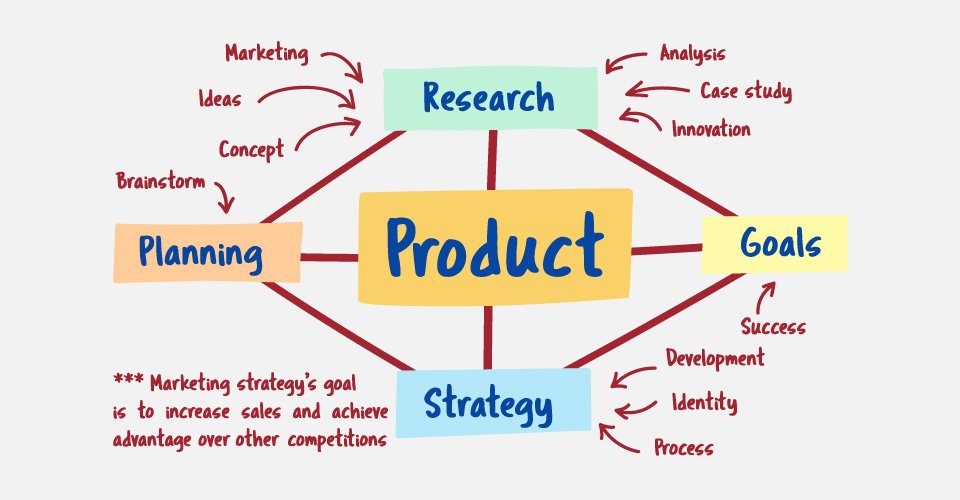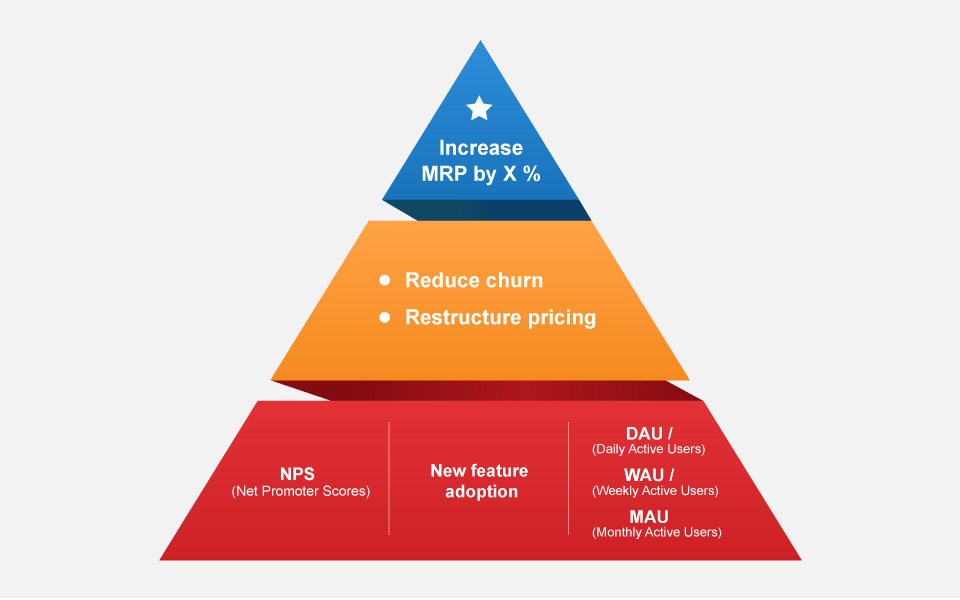- Strategy
- 10 min read
- March 2021
Develop a Winning Strategy for Successful Product Launch
If you run a successful business, there is no need to highlight the importance of digital transformation. To achieve business agility and unlock new growth opportunities, every business must have a winning strategy, and the roadmap for meeting long-term goals under uncertain conditions.
The fun part of running a business is the uncertainty that comes with it. But it is fun only if you know or have deployed the countermeasures to deal with it.
Moreover, managing a product without a strategy is not advisable. It makes no sense to move ahead with your product in the competitive market without a concrete action plan.
What is a product strategy?

It is imperative to note that you are designing them for users when you are designing new products. The appreciation or critique these products receive will reflect the thought process you and your entire team put into action while making it ready to market.
As we said previously, a product strategy is a plan that helps you as a business to know what you want to achieve and how well you want the results to be. A digital product development strategy enables you to create and further develop a product to achieve your business goals. It provides direction to the team, often specifying the time, actions, and decisions needed to get close to your end goals.
Why is product strategy important for your business?
Let’s say you are sailing a boat. The sky is clear; the sun shines brightly on the surface of a calm sea. You can see the horizon, and you love every minute of it. But the sea turns treacherous with enormous waves of the tempest threatening to obliterate you and your ship from existence.
Your business is the same. There is always an uncertainty looming around your product, and a product strategy is that voyage plan and checklist that will help you sail to safety. We hope this analogy allowed you to glimpse the importance of having a product strategy for your business. Let us now briefly understand the importance of product development strategy.
A product strategy is an advanced blueprint that fulfills vital queries like -
- Who will use this product?
- How do the users/customers benefit from using this product?
- What will be the product roadmap and the company’s goals throughout the product lifecycle?
A “winning” product strategy allows businesses to prioritize their product roadmap by implementing the proper plans and accurately allocating available time and resources. There are three practical purposes that a winning product strategy fulfills.
1. Providing a clear path for you as a business

As a business, you are aware that you must seize market opportunities with a product that has a lower time-to-market. If you can provide a product with better customer connectivity, you will leave a mark as an industry expert.
If you successfully communicate a well-thought-out product strategy, your team can deliver a quality product to a market that is already brimming with competitors. The product development team will quickly grasp the importance of creating a product that contributes to companywide goals.
Most often, developers miss their work's predominant objective due to the various details involved in developing the right product. A winning product strategy keeps them connected to the fact and provides them with a more straightforward path.
In the absence of a product strategy, your sales and marketing teams fail to anticipate the path for promoting the product. Product strategy allows them to articulate the benefits rather than features and define the unique selling proposition (USP). It also enables your customer success team to grasp the product’s use cases better and base their support in a more informed and rational manner.
2. Prioritizing the product roadmap

Once you secure the interested party’s accord for your proposal, you need to put your strategy into a high-level action plan, thus coming up with an operational product roadmap.
What is a product roadmap?
A product roadmap is a plan of action that lays down the path a product will take as it evolves.
Product owners use roadmaps to outline future product functionality and to decide the feature releases.
While using agile development, a roadmap dictates a clear context for the team's daily tasks and routines. It is drafted to be responsive to the shifts taking place in the dynamic and competitive landscape.
In other words, a product roadmap is used by development teams to outline the vision, direction, priorities, and progress of a product over time. It also includes the action plan aligned with the short and long-term goals for the product and achieving these goals.
Why is it essential to have a product roadmap in Agile?
A product roadmap is a crucial draft that communicates how businesses will achieve long-term business goals. When companies understand a roadmap's role and create a great one, they can successfully move their teams toward developing the product under the designated timeline.
Yet, product teams often skip the strategy-drafting stage to save time and start enlisting themes and epics on their product roadmap. When there is no product strategy for guiding the teams in making these decisions, unwanted items start getting priority, resulting in the mismanagement of limited time and resources.
3. Improving the way teams make tactical decisions

Product development takes place with time-to-market in mind, but it is tough to deliver a product to the market without following a concrete plan. Yes, various factors come into play and influence the development process. That is why a roadmap includes these factors so that product managers and the team can adjust their plans and priorities.
With a clearly defined product strategy, businesses enable their teams to have an initial plan they can refer back to. They can make smarter tactical decisions to adjust their agenda and not lose sight of the goals or compromise time and resources.
How can digital businesses use product thinking to succeed in the market?
Today, in the digital transformation age, businesses should design, build, and maintain digital tools and platforms and lend seamless support to these tools with the right way of thinking.
Crafting smoother and more beautiful customer experiences for the client is crucial to success in this competitive market. To transform your legacy business, you will require the help of ingenious and intuitive products that offer engaging customer experiences and deliver the much-needed ROI.
Many businesses are achieving this feat by combining product development techniques with the “product thinking” approach.
What is product thinking?

To be successful in an era driven by digital transformation, businesses must design, build, and maintain digital experiences with the right way of thinking. Many companies have already started combining product development techniques with a startup mindset, a new product thinking approach.
Businesses stuck with the working process used in the 20th century seem to face the challenge of breaking free from the legacy operations structures. The struggle is of moving towards a digitally transformed business due to the lack of plan, resources, or intent.
Today, all the successful businesses are design-led, Facebook, Google, Amazon, Tesla, Airbnb, Uber, and Spotify, to name a few. Their success can be attributed to product thinking, human-centered design, lean delivery, and modern engineering marvel. They like to design memorable and engaging product experiences.
These companies are growing the value others derive from their product by meeting their end-users' needs. An app or a website is a product by the owner, but isn’t it made for the customers, the ultimate end-users?
It can only be termed as a product when it successfully solves the issues or problems the end-user is facing. In short, your product needs to be targeted at resolving current problems with the foresight of future issues too.
Product thinking is about prioritizing the features and adding them to the app or website at the correct time. You cannot dump everything you have on a product and accept that it will be a success or be loved by the users and solve their impending problems.
It is also about business, design, and technology. It allows the company to think from viability, technical feasibility, and customer perspective and enhance the product to take it to the next level.
The elements of effective product strategy
Although we cannot say there is an ultimate blueprint for developing your winning product strategy, in this section, we will share a handful of elements that excellent product strategies have in common.
1. Having a purpose
Yes, this is crucial for many reasons. Why would you grace the market with a product that does not need it? You will not; any sane thinker will not. Products must have a purpose for their existence in the market.
Finding the purpose of your product and the reason buyer personas will shell out moolah from their pocket for it is the first step in making your product a success, and that is very important to include in a product strategy.
2. Understanding customer needs and their dynamics
Products bank heavily on customers for success, and every product strategy needs to be based on meeting the needs of the customers and the change in those needs.
You will agree that customers do not always know what they want; the best example is the iPhone launch, a mobile device that did not have any physical button on its screen (apart from that home button). You remember it, don’t you, it was quite some news in that era!
So, back to the point! Yes, product strategy needs to bridge the gap between customers and their changing needs. Their needs change with time, and so should your product and its offerings.
3. Understanding the value chain
Products do not lie in space, and neither do the users. Your product strategy needs to incorporate how the product will fit an ecosystem, determine how and where it adds value, and identify friction points.
With changes in the ecosystem, the role of your product inside that ecosystem will also change.
4. Determining future changes
No, you do need to be psychic to forecast the changes; let data help you out in this category. Your team of strategic thinkers will have to utilize the data available from the market to analyze and anticipate the future changes that may disrupt the market and how your product fits the ecosystem.
Having a way of determining future changes allows your business to understand how the anticipated future may affect your product’s growth opportunities and usage.
5. Aligning the apt actions for these changes
Now that you know what will or might affect your product's position in the market, you can include the information in your product strategy, suggest some mitigation points, and turn the tables to seize the market opportunities.
6. Measuring the success and preparing for course correction
It is impossible to know which strategy might or might not work if you do not have any means of measuring the success rate. It would help if you had metrics in place to track your product strategy's progress and execution. The KPIs must also highlight any potential downward slide so that apt course corrections can be made.

Your product strategy must be more than a series of measurable metrics; these metrics are essential in defining and executing the product strategy. This does not mean that product managers should reinvent the wheel in defining product metrics. There are existing, well-understood, and valuable metrics at their disposal with instrumentation and reporting; the trick is to concentrate on one of them.
Your product’s maturity in the market helps you understand which metrics are relevant for a particular product strategy phase.
When the users start using your product, and the analytics start rolling in, product managers can use metrics to adjust and enhance the product strategy. This data from the end-user enables businesses to create a valuable feedback loop for their product and execute plans from their product strategy as the product grows.
Concluding thoughts: Develop a winning product strategy to stay resilient
As discussed in this article, an effective product strategy is vital to clear out the path you want your product to take. It involves having a plan and various countermeasures to deal with unseen disruption from the market dynamics.
One such upheaval the world experienced was Covid-19, which almost brought the world to a standstill. But digital transformation and the advent of technological tools proved that businesses need to move away from legacy systems and processes if they want to stay resilient.
Rapidops leverages its expertise in technology, market research, customer experiences, and data analytics to help global businesses devise disruptive strategies for their mission-critical digital opportunities.
Tap into our best minds to bring new product ideas and growth plans to life. Contact us now to get a free consultation on your digital opportunity.




